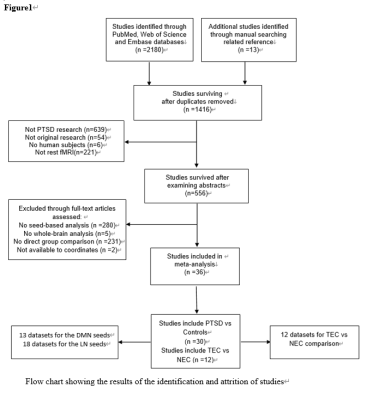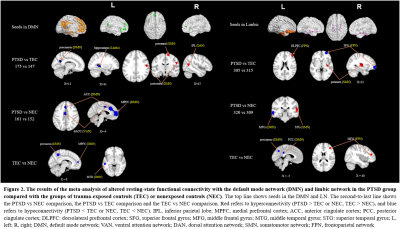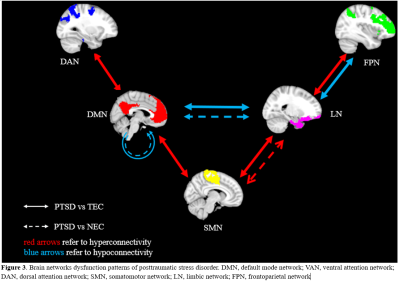1667
Alternations of functional networks in adult PTSD: a systematic review and meta-analysis of resting-state functional connectivity studies1Huaxi MR Research Center (HMRRC), Functional and Molecular Imaging Key Laboratory of Sichuan Province, Department of Radiology, West China Hospital, Sichuan University, Chengdu, China
Synopsis
We performed a systematic review of studies which explored network alterations by comparing PTSD and trauma-exposed controls (TEC) or nonexposed controls (NEC) using seed-based functional connectivity (SBFC) techniques. And quantitative meta-analysis was conducted when the number of studies reached an appropriate number. Our results supported that trauma may have long-lasting effects on the function of the default mode network (DMN) and limbic network (LN) regardless of whether it caused symptoms of PTSD. Moreover, the altered connectivity between the DMN and the somatomotor network (SMN) and between the LN and SMN may be underline neural mechanism specify to PTSD.
Introduction
Posttraumatic stress disorder (PTSD) may develop following exposure to extremely traumatic events such as war, combat, natural disasters, child abuse, traffic accidents and so on [1]. Many brain structural and functional magnetic resonance imaging (MRI) studies have been performed to explore the neurobiology of PTSD. But it remains unclear what specific effect disease or trauma have on brain function in patients with PTSD. Clarify those specific effects can help us to better understand the neurobiology mechanism underlying this disorder. Therefore, we integrated the rsFC studies of PTSD and trauma-exposed controls (TEC) to explore the effect of disease and trauma on brain function.Methods
Relevant studies have been searched in the PubMed, Web of Science and EMBASE databases using the keywords ‘posttraumatic stress disorder’ or ‘PTSD’ or ‘trauma’ plus ‘rest*’ or ‘functional magnetic resonance imaging’ or ‘fMRI’ plus ‘connect*’ before 25 August 2020. We also manually searched relevance reference to obtain additional studies. Studies which used seed-based analysis to explore resting state FC in PTSD were included. Seeds in those studies were categorized into a priori seven functional networks including the default mode network (DMN), frontoparietal network (FPN), ventral attention network (VAN), dorsal attention network (DAN), limbic network (LN; previously called the affective network), somatomotor network (SMN) and visual network [2]. The coordinates of regions which showed significant difference in FC between PTSD patients and controls were extracted to analysis. Firstly, meta-analysis of PTSD compared to TEC and NEC was conducted separately using Anisotropic effect size signed differential mapping (AES-SDM) software package [3]. Secondly, a systematic review of functional studies that compared TEC with NEC was performed to help identify the specific effects of trauma on FC. Additionally, jackknife and heterogeneity analysis were performed to estimate the robustness and heterogeneity of our results.Results
Our search strategy yielded 13 datasets from 9 original studies for the DMN seeds, including 314 PTSD patients and 281 controls (129 TEC and 152 NEC), 18 datasets from 14 studies for the LN seeds included 625 PTSD patients and 624 controls (315 TEC and 309 NEC) (Figure1). We found hypoconnectivity within the DMN and between DMN and LN when PTSD compared to NEC and TEC (Figure2, 3). Hyperconnectivity between SMN and DMN and LN was found when PTSD compared to TEC (Figure2, 3). Between-group heterogeneity was found in the right medical prefrontal cortex (MPFC) in the PTSD vs NEC and in the right inferior parietal lobe (IPL), pre-/postcentral gyrus in the PTSD vs TEC. All results remained significant in all but two or three combinations of datasets.Discussion & Conclusion
The present study revealed different patterns of brain network alterations between PTSD and healthy controls depending on whether the controls were trauma-exposed or not. The findings suggest that trauma may have long-lasting effects on the function of the DMN and LN regardless of whether it caused symptoms of PTSD. The trauma effect on DMN was consistent with previous study findings which reported DMN alterations after experiencing trauma [4,5]. Additionally, the abnormal FC between the DMN and VAN is more likely associated with trauma itself and not be specifically involved in the development of PTSD. However, altered connectivity between the DMN and the somatomotor network (SMN) and between the LN and SMN may be underline neural mechanism specify to PTSD.Summary of Main Findings
Our findings suggested that the long-lasting effect of trauma on the function of the default mode network (DMN) and limbic network (LN) regardless of whether it caused symptoms of PTSD.Acknowledgements
This study was supported by the National Natural Science Foundation (Grant No. 81671669)References
[1]. Association, A.P., 2013. Diagnostic and Statistical Manual of Mental Disorders, 5th ed. American Psychiatric Association, Arlingtion.
[2]. Yeo BT, Krienen FM, Sepulcre J, Sabuncu MR, Lashkari D, Hollinshead M, Roffman JL, Smoller JW, Zollei L, Polimeni JR, Fischl B, Liu H and Buckner RL (2011) The organization of the human cerebral cortex estimated by intrinsic functional connectivity. Journal of Neurophysiology 106, 1125–1165.
[3]. Radua, J., et al., Anisotropic kernels for coordinate-based meta-analyses of neuroimaging studies. Front Psychiatry, 2014. 5: p. 13.
[4]. Lui S, Huang X, Chen L, Tang H, Zhang T, Li X, Li D, Kuang W, Chan RC, Mechelli A, Sweeney JA, Gong Q. High-field MRI reveals an acute impact on brain function in survivors of the magnitude 8.0 earthquake in China. Proc Natl Acad Sci U S A. 2009 Sep 8;106(36):15412-7. doi:10.1073/pnas.0812751106. Epub 2009 Aug 31. PMID: 19720989; PMCID: PMC2735557.
[5]. Lu S, Gao W, Wei Z, Wang D, Hu S, Huang M, Xu Y, Li L. Intrinsic brain abnormalities in young healthy adults with childhood trauma: A resting-state functional magnetic resonance imaging study of regional homogeneity and functional connectivity. Aust N Z J Psychiatry. 2017 Jun;51(6):614-623. doi: 10.1177/0004867416671415. Epub 2016 Sep 30. PMID: 27694638.
Figures


